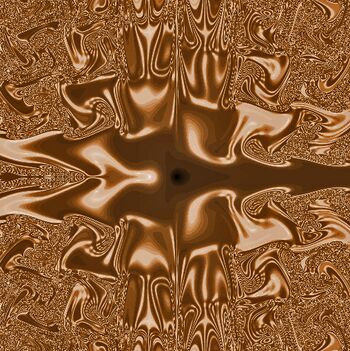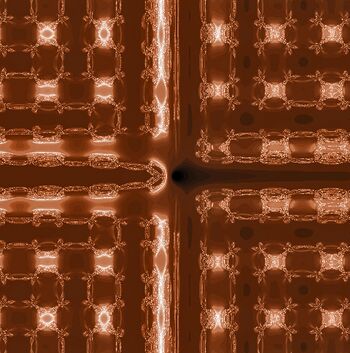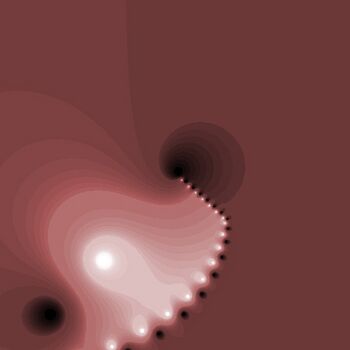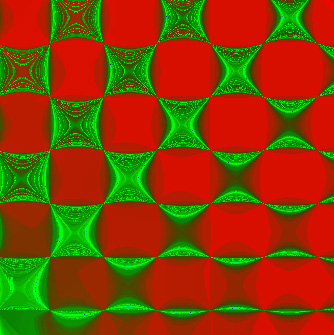Infinite compositions of analytic functions
In mathematics, infinite compositions of analytic functions (ICAF) offer alternative formulations of analytic continued fractions, series, products and other infinite expansions, and the theory evolving from such compositions may shed light on the convergence/divergence of these expansions. Some functions can actually be expanded directly as infinite compositions. In addition, it is possible to use ICAF to evaluate solutions of fixed point equations involving infinite expansions. Complex dynamics offers another venue for iteration of systems of functions rather than a single function. For infinite compositions of a single function see Iterated function. For compositions of a finite number of functions, useful in fractal theory, see Iterated function system.
Although the title of this article specifies analytic functions, there are results for more general functions of a complex variable as well.
Notation
There are several notations describing infinite compositions, including the following:
Forward compositions: [math]\displaystyle{ F_{k,n}(z) = f_k \circ f_{k + 1} \circ \dots \circ f_{n - 1} \circ f_n (z). }[/math]
Backward compositions: [math]\displaystyle{ G_{k,n}(z) = f_n \circ f_{n - 1} \circ \dots \circ f_{k + 1} \circ f_k (z). }[/math]
In each case convergence is interpreted as the existence of the following limits:
- [math]\displaystyle{ \lim_{n\to \infty} F_{1,n}(z), \qquad \lim_{n\to\infty} G_{1,n}(z). }[/math]
For convenience, set Fn(z) = F1,n(z) and Gn(z) = G1,n(z).
One may also write [math]\displaystyle{ F_n(z)=\underset{k=1}{\overset{n}{\mathop R}}\,f_k(z)=f_1 \circ f_2\circ \cdots \circ f_n(z) }[/math] and [math]\displaystyle{ G_n(z)=\underset{k=1}{\overset{n}{\mathop L}}\,g_k(z)=g_n \circ g_{n-1}\circ \cdots \circ g_1(z) }[/math]
Contraction theorem
Many results can be considered extensions of the following result:
Contraction Theorem for Analytic Functions[1] — Let f be analytic in a simply-connected region S and continuous on the closure S of S. Suppose f(S) is a bounded set contained in S. Then for all z in S there exists an attractive fixed point α of f in S such that: [math]\displaystyle{ F_n(z)=(f\circ f\circ \cdots \circ f)(z)\to \alpha. }[/math]
Infinite compositions of contractive functions
Let {fn} be a sequence of functions analytic on a simply-connected domain S. Suppose there exists a compact set Ω ⊂ S such that for each n, fn(S) ⊂ Ω.
Forward (inner or right) Compositions Theorem — {Fn} converges uniformly on compact subsets of S to a constant function F(z) = λ.[2]
Backward (outer or left) Compositions Theorem — {Gn} converges uniformly on compact subsets of S to γ ∈ Ω if and only if the sequence of fixed points {γn} of the {fn} converges to γ.[3]
Additional theory resulting from investigations based on these two theorems, particularly Forward Compositions Theorem, include location analysis for the limits obtained in the following reference.[4] For a different approach to Backward Compositions Theorem, see the following reference.[5]
Regarding Backward Compositions Theorem, the example f2n(z) = 1/2 and f2n−1(z) = −1/2 for S = {z : |z| < 1} demonstrates the inadequacy of simply requiring contraction into a compact subset, like Forward Compositions Theorem.
For functions not necessarily analytic the Lipschitz condition suffices:
Theorem[6] — Suppose [math]\displaystyle{ S }[/math] is a simply connected compact subset of [math]\displaystyle{ \Complex }[/math] and let [math]\displaystyle{ t_n : S \to S }[/math] be a family of functions that satisfies [math]\displaystyle{ \forall n, \forall z_1, z_2 \in S, \exists \rho: \quad \left|t_n(z_1)-t_n(z_2) \right|\le \rho |z_1-z_2|, \quad \rho \lt 1. }[/math] Define: [math]\displaystyle{ \begin{align} G_n(z) &= \left (t_n\circ t_{n-1}\circ \cdots \circ t_1 \right ) (z) \\ F_n(z) &= \left (t_1 \circ t_2\circ \cdots \circ t_n \right ) (z) \end{align} }[/math] Then [math]\displaystyle{ F_n(z)\to \beta \in S }[/math] uniformly on [math]\displaystyle{ S. }[/math] If [math]\displaystyle{ \alpha_n }[/math] is the unique fixed point of [math]\displaystyle{ t_n }[/math] then [math]\displaystyle{ G_n(z)\to \alpha }[/math] uniformly on [math]\displaystyle{ S }[/math] if and only if [math]\displaystyle{ |\alpha_n -\alpha| = \varepsilon_n \to 0 }[/math].
Infinite compositions of other functions
Non-contractive complex functions
Results involving entire functions include the following, as examples. Set
- [math]\displaystyle{ \begin{align} f_n(z)&=a_n z + c_{n,2}z^2+c_{n,3} z^3+\cdots \\ \rho_n &= \sup_r \left\{ \left| c_{n,r} \right|^{\frac{1}{r-1}} \right\} \end{align} }[/math]
Then the following results hold:
Theorem E1[7] — If an ≡ 1, [math]\displaystyle{ \sum_{n=1}^\infty \rho_n \lt \infty }[/math] then Fn → F is entire.
Theorem E2[8] — Set εn = |an−1| suppose there exists non-negative δn, M1, M2, R such that the following holds: [math]\displaystyle{ \begin{align} \sum_{n=1}^\infty \varepsilon_n &\lt \infty, \\ \sum_{n=1}^\infty \delta_n &\lt \infty, \\ \prod_{n=1}^\infty (1+\delta_n) &\lt M_1, \\ \prod_{n=1}^\infty (1+\varepsilon_n) &\lt M_2, \\ \rho_n &\lt \frac{\delta_n}{R M_1 M_2}. \end{align} }[/math] Then Gn(z) → G(z) is analytic for |z| < R. Convergence is uniform on compact subsets of {z : |z| < R}.
Additional elementary results include:
Theorem GF3[6] — Suppose [math]\displaystyle{ f_k(z)=z+\rho_k \varphi_k (z) }[/math] where there exist [math]\displaystyle{ R, M \gt 0 }[/math] such that [math]\displaystyle{ |z| \lt R }[/math] implies [math]\displaystyle{ | \varphi_k (z)| \lt M, \forall k, \ }[/math] Furthermore, suppose [math]\displaystyle{ \rho_k \ge 0, \sum_{k=1}^\infty \rho_k \lt \infty }[/math] and [math]\displaystyle{ R \gt M\sum_{k=1}^\infty \rho_k. }[/math] Then for [math]\displaystyle{ R* \lt R-M\sum_{k=1}^\infty \rho_k }[/math] [math]\displaystyle{ G_n(z)\equiv \left (f_n\circ f_{n-1}\circ \cdots \circ f_1 \right ) (z) \to G(z) \qquad \text{ for } \{z:|z|\lt R*\} }[/math]
Theorem GF4[6] — Suppose [math]\displaystyle{ f_k(z)=z+\rho_k \varphi_k (z) }[/math] where there exist [math]\displaystyle{ R, M \gt 0 }[/math] such that [math]\displaystyle{ |z|\lt R }[/math] and [math]\displaystyle{ |\zeta|\lt R }[/math] implies [math]\displaystyle{ |\varphi_k (z)| \lt M }[/math] and [math]\displaystyle{ |\varphi_k (z)-\varphi_k (\zeta)|\le r|z-\zeta|, \forall k. \ }[/math] Furthermore, suppose [math]\displaystyle{ \rho_k\ge 0, \sum_{k=1}^\infty \rho_k \lt \infty }[/math] and [math]\displaystyle{ R\gt M \sum_{k=1}^\infty \rho_k. }[/math] Then for [math]\displaystyle{ R* \lt R-M\sum_{k=1}^\infty\rho_k }[/math] [math]\displaystyle{ F_n(z)\equiv \left (f_1\circ f_2\circ \cdots \circ f_n \right) (z) \to F(z) \qquad \text{ for } \{z:|z|\lt R* \} }[/math]
Example GF1: [math]\displaystyle{ F_{40}(x+iy)=\underset{k=1}{\overset{40}{\mathop R}} \left( \frac{x+iy}{1+\tfrac{1}{4^k} (x\cos(y)+iy\sin(x))} \right),\qquad[-20,20] }[/math][9]
Example GF2: [math]\displaystyle{ G_{40}(x+iy)=\underset{k=1}{\overset{40}{\mathop L}}\,\left( \frac{x+iy}{1+\tfrac{1}{2^k} (x\cos(y)+iy\sin(x))} \right), \ [-20,20] }[/math]
Linear fractional transformations
Results[8] for compositions of linear fractional (Möbius) transformations include the following, as examples:
Theorem LFT1 — On the set of convergence of a sequence {Fn} of non-singular LFTs, the limit function is either:
- a non-singular LFT,
- a function taking on two distinct values, or
- a constant.
In (a), the sequence converges everywhere in the extended plane. In (b), the sequence converges either everywhere, and to the same value everywhere except at one point, or it converges at only two points. Case (c) can occur with every possible set of convergence.[10]
Theorem LFT2[11] — If {Fn} converges to an LFT, then fn converge to the identity function f(z) = z.
Theorem LFT3[12] — If fn → f and all functions are hyperbolic or loxodromic Möbius transformations, then Fn(z) → λ, a constant, for all [math]\displaystyle{ z \ne \beta = \lim_{n\to \infty} \beta_n }[/math], where {βn} are the repulsive fixed points of the {fn}.
Theorem LFT4[13] — If fn → f where f is parabolic with fixed point γ. Let the fixed-points of the {fn} be {γn} and {βn}. If [math]\displaystyle{ \sum_{n=1}^\infty \left|\gamma_n-\beta_n \right| \lt \infty \quad \text{and} \quad \sum_{n=1}^\infty n \left|\beta_{n+1}-\beta_n \right|\lt \infty }[/math] then Fn(z) → λ, a constant in the extended complex plane, for all z.
Examples and applications
Continued fractions
The value of the infinite continued fraction
- [math]\displaystyle{ \cfrac{a_1}{b_1+\cfrac{a_2}{b_2+\cdots}} }[/math]
may be expressed as the limit of the sequence {Fn(0)} where
- [math]\displaystyle{ f_n(z)=\frac{a_n}{b_n+z}. }[/math]
As a simple example, a well-known result (Worpitsky Circle*[14]) follows from an application of Theorem (A):
Consider the continued fraction
- [math]\displaystyle{ \cfrac{a_1\zeta }{1+\cfrac{a_2\zeta }{1+\cdots}} }[/math]
with
- [math]\displaystyle{ f_n(z)=\frac{a_n \zeta }{1+z}. }[/math]
Stipulate that |ζ| < 1 and |z| < R < 1. Then for 0 < r < 1,
- [math]\displaystyle{ |a_n|\lt rR(1-R)\Rightarrow \left|f_n(z) \right|\lt rR\lt R\Rightarrow \frac{a_1\zeta }{1+\frac{a_2\zeta }{1+\cdots}} = F(\zeta) }[/math], analytic for |z| < 1. Set R = 1/2.
Example. [math]\displaystyle{ F(z)=\frac{(i-1)z}{1+i+z\text{ }+}\text{ }\frac{(2-i)z}{1+2i+z\text{ }+}\text{ }\frac{(3-i)z}{1+3i+z\text{ }+} \cdots, }[/math] [math]\displaystyle{ [-15,15] }[/math]
Example.[8] A fixed-point continued fraction form (a single variable).
- [math]\displaystyle{ f_{k,n}(z)=\frac{\alpha_{k,n} \beta_{k,n}}{\alpha_{k,n}+\beta_{k,n}-z}, \alpha_{k,n}=\alpha_{k,n}(z), \beta_{k,n}=\beta_{k,n}(z), F_n(z)= \left (f_{1,n} \circ\cdots \circ f_{n,n} \right ) (z) }[/math]
- [math]\displaystyle{ \alpha_{k,n}=x \cos(ty)+iy \sin(tx), \beta_{k,n}= \cos(ty)+i \sin(tx), t=k/n }[/math]
Direct functional expansion
Examples illustrating the conversion of a function directly into a composition follow:
Example 1.[7][15] Suppose [math]\displaystyle{ \phi }[/math] is an entire function satisfying the following conditions:
- [math]\displaystyle{ \begin{cases} \phi (tz)=t\left( \phi (z)+\phi (z)^2 \right) & |t|\gt 1 \\ \phi(0) = 0 \\ \phi'(0) =1 \end{cases} }[/math]
Then
- [math]\displaystyle{ f_n(z)=z+\frac{z^2}{t^n}\Longrightarrow F_n(z)\to \phi (z) }[/math].
Example 2.[7]
- [math]\displaystyle{ f_n(z)=z+\frac{z^2}{2^n}\Longrightarrow F_n(z)\to \frac{1}{2}\left( e^{2z}-1 \right) }[/math]
Example 3.[6]
- [math]\displaystyle{ f_n(z)= \frac{z}{1-\tfrac{z^2}{4^n}}\Longrightarrow F_n(z)\to \tan (z) }[/math]
Example 4.[6]
- [math]\displaystyle{ g_n(z)=\frac{2 \cdot 4^{n}}{z} \left ( \sqrt{1+\frac{z^2}{4^{n}}}-1 \right )\Longrightarrow G_n(z) \to \arctan (z) }[/math]
Calculation of fixed-points
Theorem (B) can be applied to determine the fixed-points of functions defined by infinite expansions or certain integrals. The following examples illustrate the process:
Example FP1.[3] For |ζ| ≤ 1 let
- [math]\displaystyle{ G(\zeta )=\frac{ \tfrac{e^\zeta}{4}}{3+\zeta +\cfrac{\tfrac{e^\zeta} 8 }{3+\zeta + \cfrac{\tfrac{e^\zeta}{12}}{3+\zeta +\cdots}}} }[/math]
To find α = G(α), first we define:
- [math]\displaystyle{ \begin{align} t_n(z)&=\cfrac{\tfrac{e^\zeta}{4n}}{3+\zeta +z} \\ f_n(\zeta )&= t_1\circ t_2\circ \cdots \circ t_n(0) \end{align} }[/math]
Then calculate [math]\displaystyle{ G_n(\zeta )=f_n\circ \cdots \circ f_1(\zeta ) }[/math] with ζ = 1, which gives: α = 0.087118118... to ten decimal places after ten iterations.
Theorem FP2[8] — Let φ(ζ, t) be analytic in S = {z : |z| < R} for all t in [0, 1] and continuous in t. Set [math]\displaystyle{ f_n (\zeta)=\frac{1}{n} \sum_{k=1}^n \varphi \left( \zeta ,\tfrac{k}{n} \right). }[/math] If |φ(ζ, t)| ≤ r < R for ζ ∈ S and t ∈ [0, 1], then [math]\displaystyle{ \zeta =\int_0^1 \varphi (\zeta ,t) \, dt }[/math] has a unique solution, α in S, with [math]\displaystyle{ \lim_{n\to \infty} G_n(\zeta ) = \alpha. }[/math]
Evolution functions
Consider a time interval, normalized to I = [0, 1]. ICAFs can be constructed to describe continuous motion of a point, z, over the interval, but in such a way that at each "instant" the motion is virtually zero (see Zeno's Arrow): For the interval divided into n equal subintervals, 1 ≤ k ≤ n set [math]\displaystyle{ g_{k,n}(z)=z+\varphi_{k,n}(z) }[/math] analytic or simply continuous – in a domain S, such that
- [math]\displaystyle{ \lim_{n\to \infty}\varphi_{k,n}(z)=0 }[/math] for all k and all z in S,
and [math]\displaystyle{ g_{k,n}(z) \in S }[/math].
Principal example[8]
- [math]\displaystyle{ \begin{align} g_{k,n}(z) &=z+\frac{1}{n}\phi \left (z,\tfrac{k}{n} \right ) \\ G_{k,n}(z) &= \left (g_{k,n}\circ g_{k-1,n} \circ \cdots \circ g_{1,n} \right ) (z) \\ G_n(z) &=G_{n,n}(z) \end{align} }[/math]
implies
- [math]\displaystyle{ \lambda_n(z)\doteq G_n(z)-z=\frac{1}{n}\sum_{k=1}^n \phi \left( G_{k-1,n}(z)\tfrac k n \right)\doteq \frac 1 n \sum_{k=1}^n \psi \left (z,\tfrac{k}{n} \right) \sim \int_0^1 \psi (z,t)\,dt, }[/math]
where the integral is well-defined if [math]\displaystyle{ \tfrac{dz}{dt}=\phi (z,t) }[/math] has a closed-form solution z(t). Then
- [math]\displaystyle{ \lambda_n(z_0)\approx \int_0^1 \phi ( z(t),t)\,dt. }[/math]
Otherwise, the integrand is poorly defined although the value of the integral is easily computed. In this case one might call the integral a "virtual" integral.
Example. [math]\displaystyle{ \phi (z,t)=\frac{2t-\cos y}{1-\sin x\cos y}+i\frac{1-2t\sin x}{1-\sin x\cos y}, \int_0^1 \psi (z,t) \, dt }[/math]
Example. Let:
- [math]\displaystyle{ g_n(z)=z+\frac{c_n}{n}\phi (z), \quad \text{with} \quad f(z) = z + \phi(z). }[/math]
Next, set [math]\displaystyle{ T_{1,n}(z)=g_n(z), T_{k,n}(z)= g_n(T_{k-1,n}(z)), }[/math] and Tn(z) = Tn,n(z). Let
- [math]\displaystyle{ T(z)=\lim_{n\to \infty} T_n(z) }[/math]
when that limit exists. The sequence {Tn(z)} defines contours γ = γ(cn, z) that follow the flow of the vector field f(z). If there exists an attractive fixed point α, meaning |f(z) − α| ≤ ρ|z − α| for 0 ≤ ρ < 1, then Tn(z) → T(z) ≡ α along γ = γ(cn, z), provided (for example) [math]\displaystyle{ c_n = \sqrt{n} }[/math]. If cn ≡ c > 0, then Tn(z) → T(z), a point on the contour γ = γ(c, z). It is easily seen that
- [math]\displaystyle{ \oint_\gamma \phi (\zeta ) \, d\zeta =\lim_{n\to \infty}\frac c n \sum_{k=1}^n \phi ^2 \left (T_{k-1,n}(z) \right ) }[/math]
and
- [math]\displaystyle{ L(\gamma (z))=\lim_{n\to \infty} \frac{c}{n}\sum_{k=1}^n \left| \phi \left (T_{k-1,n}(z) \right ) \right|, }[/math]
when these limits exist.
These concepts are marginally related to active contour theory in image processing, and are simple generalizations of the Euler method
Self-replicating expansions
Series
The series defined recursively by fn(z) = z + gn(z) have the property that the nth term is predicated on the sum of the first n − 1 terms. In order to employ theorem (GF3) it is necessary to show boundedness in the following sense: If each fn is defined for |z| < M then |Gn(z)| < M must follow before |fn(z) − z| = |gn(z)| ≤ Cβn is defined for iterative purposes. This is because [math]\displaystyle{ g_n(G_{n-1}(z)) }[/math] occurs throughout the expansion. The restriction
- [math]\displaystyle{ |z|\lt R=M-C\sum_{k=1}^\infty \beta_k \gt 0 }[/math]
serves this purpose. Then Gn(z) → G(z) uniformly on the restricted domain.
Example (S1). Set
- [math]\displaystyle{ f_n(z)=z+\frac{1}{\rho n^2}\sqrt{z}, \qquad \rho \gt \sqrt{\frac{\pi}{6}} }[/math]
and M = ρ2. Then R = ρ2 − (π/6) > 0. Then, if [math]\displaystyle{ S=\left\{ z: |z|\lt R,\operatorname{Re}(z)\gt 0 \right\} }[/math], z in S implies |Gn(z)| < M and theorem (GF3) applies, so that
- [math]\displaystyle{ \begin{align} G_n(z) &=z+g_1(z)+g_2(G_1(z))+g_3(G_2(z))+\cdots + g_n(G_{n-1}(z)) \\ &= z+\frac{1}{\rho \cdot 1^2}\sqrt{z}+\frac{1}{\rho \cdot 2^2}\sqrt{G_1(z)}+\frac{1}{\rho \cdot 3^2}\sqrt{G_2(z)}+\cdots +\frac{1}{\rho \cdot n^2} \sqrt{G_{n-1}(z)} \end{align} }[/math]
converges absolutely, hence is convergent.
Example (S2): [math]\displaystyle{ f_n(z)=z+\frac 1 {n^2}\cdot \varphi (z), \varphi (z)=2\cos(x/y)+i2\sin (x/y), \gt G_n(z)=f_n \circ f_{n-1}\circ \cdots \circ f_1(z), \qquad [-10,10], n=50 }[/math]
Products
The product defined recursively by
- [math]\displaystyle{ f_n(z)=z( 1+g_n(z)), \qquad |z| \leqslant M, }[/math]
has the appearance
- [math]\displaystyle{ G_n(z) = z \prod _{k=1}^n \left( 1+g_k \left( G_{k-1}(z) \right) \right). }[/math]
In order to apply Theorem GF3 it is required that:
- [math]\displaystyle{ \left| zg_n(z) \right|\le C\beta_n, \qquad \sum_{k=1}^\infty \beta_k\lt \infty. }[/math]
Once again, a boundedness condition must support
- [math]\displaystyle{ \left|G_{n-1}(z) g_n(G_{n-1}(z))\right|\le C \beta_n. }[/math]
If one knows Cβn in advance, the following will suffice:
- [math]\displaystyle{ |z| \leqslant R = \frac{M}{P} \qquad \text{where} \quad P = \prod_{n=1}^\infty \left( 1+C\beta_n\right). }[/math]
Then Gn(z) → G(z) uniformly on the restricted domain.
Example (P1). Suppose [math]\displaystyle{ f_n(z)=z(1+g_n(z)) }[/math] with [math]\displaystyle{ g_n(z)=\tfrac{z^2}{n^3}, }[/math] observing after a few preliminary computations, that |z| ≤ 1/4 implies |Gn(z)| < 0.27. Then
- [math]\displaystyle{ \left|G_n(z) \frac{G_n(z)^2}{n^3} \right|\lt (0.02)\frac{1}{n^3}=C\beta_n }[/math]
and
- [math]\displaystyle{ G_n(z)=z \prod_{k=1}^{n-1}\left( 1+\frac{G_k(z)^2}{n^3}\right) }[/math]
converges uniformly.
Example (P2).
- [math]\displaystyle{ g_{k,n}(z)=z\left( 1+\frac 1 n \varphi \left (z,\tfrac k n \right ) \right), }[/math]
- [math]\displaystyle{ G_{n,n}(z)= \left( g_{n,n}\circ g_{n-1,n}\circ \cdots \circ g_{1,n} \right ) (z) = z\prod_{k=1}^n ( 1+P_{k,n}(z)), }[/math]
- [math]\displaystyle{ P_{k,n}(z)=\frac 1 n \varphi \left (G_{k-1,n}(z),\tfrac{k}{n} \right ), }[/math]
- [math]\displaystyle{ \prod_{k=1}^{n-1} \left( 1+P_{k,n}(z) \right) = 1+P_{1,n}(z)+P_{2,n}(z)+\cdots + P_{k-1,n}(z) + R_n(z) \sim \int_0^1 \pi (z,t) \, dt + 1+R_n(z), }[/math]
- [math]\displaystyle{ \varphi (z)=x\cos(y)+iy\sin(x), \int_0^1 (z\pi (z,t)-1) \,dt, \qquad [-15,15]: }[/math]
Continued fractions
Example (CF1): A self-generating continued fraction.[8]
- [math]\displaystyle{ \begin{align} F_n(z) &= \frac{\rho (z)}{\delta_1+} \frac{\rho (F_1(z))}{\delta_2 +} \frac{\rho (F_2(z))}{\delta_3+} \cdots \frac{\rho (F_{n-1}(z))}{\delta_n}, \\ \rho (z) &= \frac{\cos(y)}{\cos (y)+\sin (x)}+i\frac{\sin(x)}{\cos (y)+\sin (x)}, \qquad [0\lt x\lt 20],[0\lt y\lt 20], \qquad\delta_k\equiv 1 \end{align} }[/math]
Example (CF2): Best described as a self-generating reverse Euler continued fraction.[8]
- [math]\displaystyle{ G_n(z)=\frac{\rho (G_{n-1}(z))}{1+\rho (G_{n-1}(z))-}\ \frac{\rho (G_{n-2}(z))}{1+\rho (G_{n-2}(z))-}\cdots \frac{\rho (G_1(z))}{1+\rho (G_1(z))-}\ \frac{\rho (z)}{1+\rho (z)-z}, }[/math]
- [math]\displaystyle{ \rho (z)=\rho (x+iy)=x\cos(y)+iy\sin(x), \qquad [-15,15], n=30 }[/math]
See also
References
- ↑ Henrici, P. (1988). Applied and Computational Complex Analysis. 1. Wiley. ISBN 978-0-471-60841-7. https://books.google.com/books?id=ZrJ6GX5a2WMC&pg=PR13.
- ↑ Lorentzen, Lisa (November 1990). "Compositions of contractions". Journal of Computational and Applied Mathematics 32 (1–2): 169–178. doi:10.1016/0377-0427(90)90428-3.
- ↑ 3.0 3.1 Gill, J. (1991). "The use of the sequence Fn(z)=fn∘⋯∘f1(z) in computing the fixed points of continued fractions, products, and series". Appl. Numer. Math. 8 (6): 469–476. doi:10.1016/0168-9274(91)90109-D.
- ↑ Keen, Linda; Lakic, Nikola (2007). "Accumulation constants of iterated function systems with Bloch target domains.". Annales Academiae Scientiarum Fennicae Mathematica (Helsinki: Finnish Academy of Science and Letters) 32 (1). https://www.maths.tcd.ie/EMIS/journals/AASF/Vol32/KeenLakic.html.
- ↑ Keen, Linda; Lakic, Nikola (2003). "Forward iterated function systems". in Jiang, Yunping. Complex dynamics and related topics: lectures from the Morningside Center of Mathematics. Sommerville: International Press. pp. 292–299. ISBN 1-57146-121-3. OCLC 699694753. http://comet.lehman.cuny.edu/keenl/forwarditer.pdf.
- ↑ 6.0 6.1 6.2 6.3 6.4 Gill, J. (2017). "A Primer on the Elementary Theory of Infinite Compositions of Complex Functions". Communications in the Analytic Theory of Continued Fractions XXIII. https://www.coloradomesa.edu/math-stat/catcf/papers/primerinfcompcomplexfcns.pdf.
- ↑ 7.0 7.1 7.2 Kojima, Shota (May 2012). "On the convergence of infinite compositions of entire functions". Archiv der Mathematik 98 (5): 453–465. doi:10.1007/s00013-012-0385-z.
- ↑ 8.0 8.1 8.2 8.3 8.4 8.5 8.6 Gill, J. (2012). "Convergence of Infinite Compositions of Complex Functions". Communications in the Analytic Theory of Continued Fractions XIX. https://www.coloradomesa.edu/math-stat/documents/JohnGillResearchnoteInfiniteCompositions2.pdf.
- ↑ https://www.researchgate.net/publication/351764310_A_Short_Note_On_the_Dynamical_System_of_the_Reproductive_Universe
- ↑ Piranian, G.; Thron, W. J. (1957). "Convergence properties of sequences of linear fractional transformations.". Michigan Mathematical Journal 4 (2). doi:10.1307/mmj/1028989001.
- ↑ de Pree, J. D.; Thron, W. J. (December 1962). "On sequences of Moebius transformations". Mathematische Zeitschrift 80 (1): 184–193. doi:10.1007/BF01162375.
- ↑ Mandell, Michael; Magnus, Arne (1970). "On convergence of sequences of linear fractional transformations". Mathematische Zeitschrift 115 (1): 11–17. doi:10.1007/BF01109744.
- ↑ Gill, John (1973). "Infinite compositions of Möbius transformations". Transactions of the American Mathematical Society 176: 479. doi:10.1090/S0002-9947-1973-0316690-6.
- ↑ Lorentzen, L.; Waadeland, H. (1992). Continued Fractions with Applications. Elsevier Science. ISBN 978-0-444-89265-2.[page needed]
- ↑ Steinmetz, N. (2011). Rational Iteration. de Gruyter. ISBN 978-3-11-088931-4. https://books.google.com/books?id=qZGWgVuGHiYC&pg=PR7.
 |











